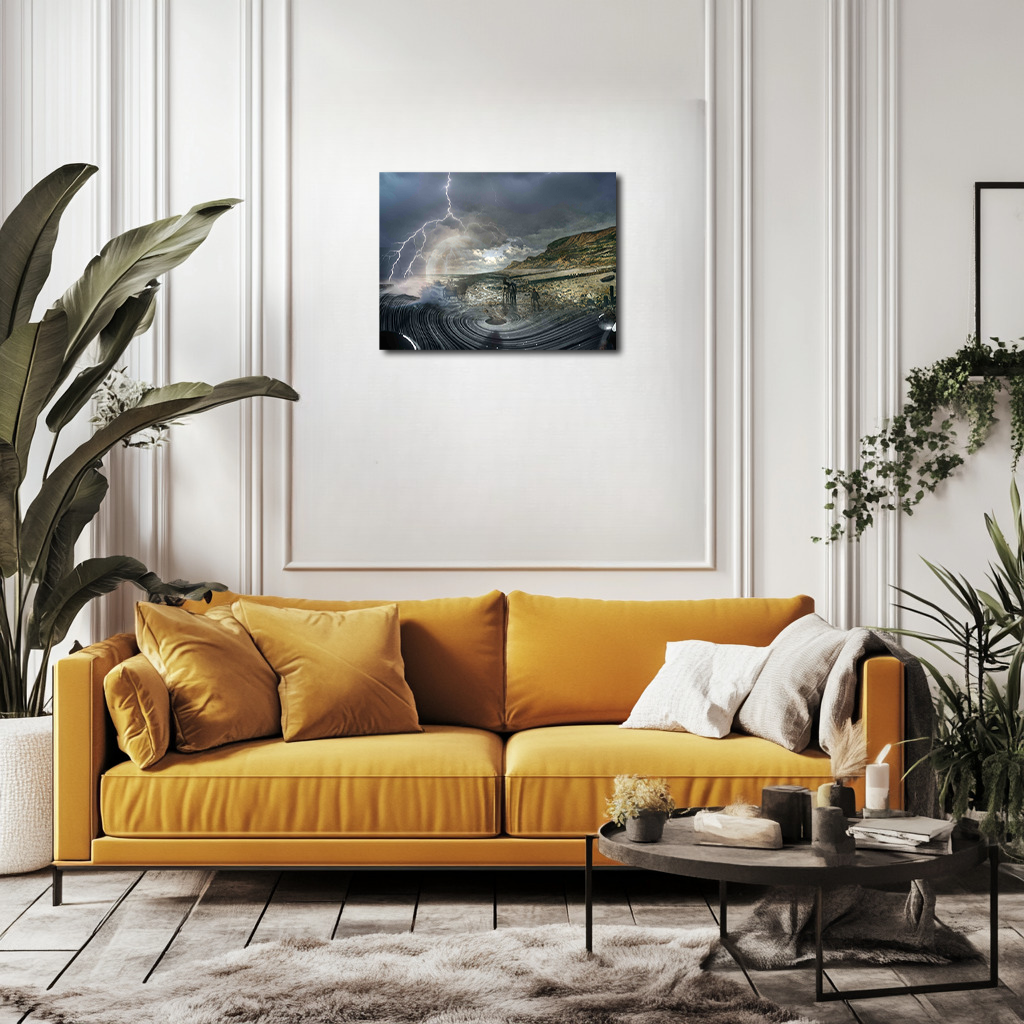The Abyss of the Tides: Unraveling the Pointe de la Hève
This surreal reinterpretation of Monet’s The Pointe de la Hève at Low Tide (1865) transforms the quiet Normandy shoreline into a cosmic unraveling of time and nature. A gravitational vortex in the foreground swallows the sea into an abyss, warping the tides beyond recognition. Lightning fractures the darkened sky, turning the once-familiar beach into a battlefield of shifting realities. The fishermen, once grounded in daily routine, now stand as relics trapped in a moment stretched infinitely across time. The cliffs retain their golden warmth, contrasting against the stormy blues and liquid blacks that consume the horizon. This work amplifies Monet’s study of fleeting light and transient landscapes, suggesting that time itself is an ever-shifting force, distorting, pulling, and reshaping existence beyond human control.
Please see Below for Details…
Hotline Order:
Mon - Fri: 07AM - 06PM
404-872-4663
Claude Monet painted The Pointe de la Hève at Low Tide in 1865, capturing the vast shoreline of Normandy in its raw, untamed essence. This work was among Monet’s earliest explorations of light, atmosphere, and the transient states of nature. The original scene portrays fishermen and villagers scattered across the rocky beach, dwarfed by the expansive sky and the receding waters. The muted palette of earthy browns, blues, and grays emphasizes the simplicity of daily coastal life while foretelling Monet’s later obsession with the ephemeral qualities of nature.
This conceptual reinterpretation plunges the familiar shoreline into a realm where reality bends under cosmic forces. The land, once a quiet meeting of earth and water, is now caught in an unsettling transformation. The sky, which in Monet’s painting was soft and luminous, now brims with storm energy, bolts of lightning cutting through the darkness. The ominous atmosphere suggests that time itself is unraveling, as the forces of nature consume the once-stable ground beneath the fishermen’s feet. The beach is no longer a passive landscape but a battleground between the forces of light and darkness, order and chaos.
A gravitational abyss forms in the foreground, pulling the waters into a spiraling void. This black hole, an impossibility in Monet’s time, now exists as a metaphor for the relentless pull of time and nature’s unpredictability. The swirling vortex suggests that even the most grounded realities can be drawn into the unknown, dissolving into forces beyond human comprehension. The ocean, usually a symbol of depth and vastness, now folds into itself, its tides no longer controlled by the moon but by a force deeper and more consuming.
Figures remain on the shore, yet they appear more like relics than living beings. Their presence, once anchored in the realism of Monet’s brushstrokes, is now spectral, as if they are trapped in a moment stretched infinitely across time. Their expressions are unreadable, their bodies standing still against the chaos forming before them. Some seem unaware of the forces at play, others glance toward the sky, sensing the impending shift in reality.
The colors in this reinterpretation move beyond the naturalistic tones of Monet’s original work. The deep storm blues and charcoals of the sky contrast with the golden-brown cliffs that retain some of their earthly warmth. Lightning injects sharp whites into the composition, cutting across the dark clouds like fractures in time. The vortex itself is composed of liquid blacks and silvers, a void that reflects light yet swallows it whole. These colors amplify the collision of elements—the past dissolving into an uncertain future, the known world eroding into something cosmic and surreal.
As an artist, my intention in transforming this scene was to elevate Monet’s fascination with transient light and fleeting moments into an exploration of time’s very structure. Monet sought to capture nature as it was, in a constant state of change, shifting from moment to moment. This interpretation amplifies that idea, suggesting that time does not merely pass—it distorts, collapses, and reforms itself in ways that humans cannot predict or control.
The gravitational pull in the foreground is symbolic of the inescapable force of history and the cycles that govern both nature and existence. The fishermen and villagers, once part of a simple coastal routine, now stand as figures caught between realities, witnesses to a force greater than their comprehension. The lightning, striking against the cliffs, signals a rupture—perhaps a breaking point, a moment where time splits and shifts.
This conceptual work is not about destruction but transformation. Just as Monet observed and documented the shifting tides, this piece reflects on the inevitable pull of change, the forces that shape landscapes, memories, and history itself. The beach at low tide, once a place of work and life, now exists as a liminal space where the fabric of time is breaking apart. It invites the viewer to stand at the edge of understanding, to peer into the abyss of the unknown, and to accept that even the most stable realities are never truly still.
Add your review
Your email address will not be published. Required fields are marked *
Please login to write review!
Looks like there are no reviews yet.








